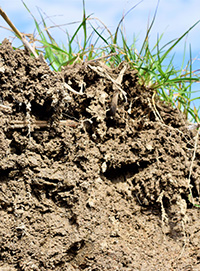 Nematodes steal marketable yield in two important ways: reducing yield and reducing marketability of harvested vegetable crops, including sweet potatoes.
Nematodes steal marketable yield in two important ways: reducing yield and reducing marketability of harvested vegetable crops, including sweet potatoes.
Nematodes, particularly root-knot, diminish yield as they feed on roots, limiting water and nutrient supply for plant growth and development.
Guava root-knot nematode (Meloidogyne enterolobii) appears to be a more virulent species that significantly reduces yield even at lower population levels. This species also reduces the portion of the crop that is marketable by producing unsightly galls on the sweet potato surface.
A microscopic threat
Nearly microscopic plant-parasitic nematodes lurking beneath the soil surface can cause devastating crop injury. Economic damage estimates put the total worldwide cost at more than $100 billion.
Nematodes insert their needle-like mouthparts, called stylets, into plant cells, damaging roots and even above-ground plant tissue.
Often, nematode damage is attributed to other causes such as drought, nutrient deficiency or disease. Symptoms of nematode damage can mimic other issues because both nematode damage and agronomic causes include the same stunting, wilting or yellowing of plant tissue. In severe cases, plants die.
According to Corteva Agriscience research, some nematode species reduce root mass, destroying fine feeder roots and disrupting nutrient and water uptake. Parasitic nematodes also cause indirect injury, including physiological and metabolic changes in host plants, and some species transmit plant viruses.
Understanding how nematicides work
Nematicides are essential control tools. But how does a nematicide’s ability to move through the soil impact its effectiveness against plant-parasitic nematodes?
Soil-applied nematicides must move through the soil well enough to target nematodes within the root zone. Too little soil distribution and the nematicide’s effects are short-lived as they become unable to protect roots as they grow. Too much soil movement and the active ingredient is diminished and is no longer effective.
Successfully targeting the root zone with ideal soil distribution requires a nematicide with optimum water solubility.
Symptoms of nematode damage can mimic other issues because both nematode damage and agronomic causes include the same stunting, wilting or yellowing of plant tissue.
“For effective control, a nematicide must exhibit the precise mobility characteristics required to get the active ingredient where it needs to be without traveling further than is needed,” says Marta Garcia, Corteva Agriscience global program leader for insecticides and nematicides.
“Some products have less soil movement, which can be a strong negative,” Garcia says. “Nematodes don’t just exist within a few inches in the soil.”
Residual activity length also depends on application rates, available moisture, temperature, microbial activity and soil type.
The More You Grow
Find expert insights on agronomics, crop protection, farm operations and more.